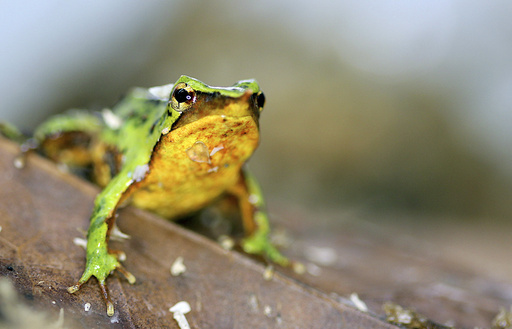LONDON — A remarkable journey transpired for a group of delicate froglets, as they journeyed thousands of miles from the forests of southern Chile to London, nestled safely within their fathers’ vocal sacs during transit.
The London Zoo announced on Monday the birth of 33 endangered Darwin’s frogs – a species named after esteemed scientist Charles Darwin, who first identified it. This initiative forms part of a vital rescue operation aimed at preventing the extinction of the species.
Recent reports indicate that recognized populations of Darwin’s frogs faced a staggering 90% reduction within just a year, following the introduction of a lethal disease known as chytrid fungus in their habitat, specifically the Parque Tantauco forests in southern Chile. This fungus has had a devastating impact on numerous amphibian species worldwide.
Darwin’s frogs are distinctive in their reproductive behavior; after the females lay their eggs, the male frogs take on the responsibility of guarding and nurturing the tiny tadpoles within their expandable vocal sacs, providing a secure developmental environment.
In October, a dedicated team of conservationists ventured into the forests of Chile in search of healthy Darwin’s frogs that were uninfected by the disease. They successfully collected 52 frogs, which were then transported in climate-controlled containers for a long journey covering 7,000 miles (approximately 11,265 kilometers) by sea, land, and air to their new location in London.
From this group, 11 male frogs, each measuring less than 3 centimeters (1.2 inches), eventually carried 33 tadpoles that were born at the zoo.
“We realized we were undertaking something extraordinary — with time running out, we had to act swiftly if we were to save these frogs,” explained Ben Tapley, the curator of amphibians at London Zoo.
He emphasized that the successful rearing of these froglets serves as a “powerful symbol of hope for the species.”
Currently, the frogs are housed in pairs within numerous glass tanks filled with moss, mimicking their natural environment in terms of temperature. Zoo staff mentioned plans to establish a breeding program for these frogs, with the intention of reintroducing any offspring into their original habitat in the future.
Andres Valenzuela-Sanchez, a researcher at ZSL, the conservation charity supporting London Zoo, highlighted that this project plays a critical role in ensuring that the species stands a chance at recovery.
“These frogs are crucial not only for the future of their species but also provide insights on how we can combat chytrid fungus and protect other amphibian populations around the world,” he stated.
This website uses cookies so that we can provide you with the best user experience possible. Cookie information is stored in your browser and performs functions such as recognising you when you return to our website and helping our team to understand which sections of the website you find most interesting and useful.
